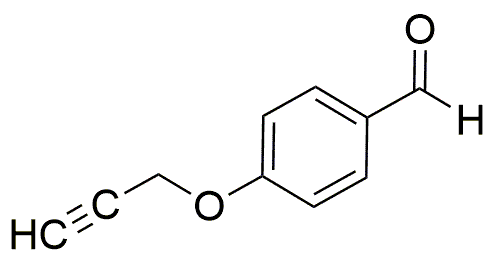4-(Propargyloxy)benzaldehyde is widely utilized in research focused on:
- Synthesis of Fine Chemicals: This compound serves as a key intermediate in the synthesis of various fine chemicals, including pharmaceuticals and agrochemicals, due to its unique reactivity.
- Organic Synthesis: It is frequently used in organic synthesis reactions, particularly in the formation of carbon-carbon bonds, which are essential for building complex molecular structures.
- Fluorescent Probes: Researchers employ this compound to develop fluorescent probes for biological imaging, enhancing the visualization of cellular processes in real-time.
- Material Science: It finds applications in the development of advanced materials, such as polymers and coatings, where its properties can enhance durability and performance.
- Drug Development: The compound is explored in drug development for its potential to modify biological activity, making it a valuable asset in creating new therapeutic agents.
General Information
Properties
Safety and Regulations
Applications
4-(Propargyloxy)benzaldehyde is widely utilized in research focused on:
- Synthesis of Fine Chemicals: This compound serves as a key intermediate in the synthesis of various fine chemicals, including pharmaceuticals and agrochemicals, due to its unique reactivity.
- Organic Synthesis: It is frequently used in organic synthesis reactions, particularly in the formation of carbon-carbon bonds, which are essential for building complex molecular structures.
- Fluorescent Probes: Researchers employ this compound to develop fluorescent probes for biological imaging, enhancing the visualization of cellular processes in real-time.
- Material Science: It finds applications in the development of advanced materials, such as polymers and coatings, where its properties can enhance durability and performance.
- Drug Development: The compound is explored in drug development for its potential to modify biological activity, making it a valuable asset in creating new therapeutic agents.
Documents
Safety Data Sheets (SDS)
The SDS provides comprehensive safety information on handling, storage, and disposal of the product.
Product Specification (PS)
The PS provides a comprehensive breakdown of the product’s properties, including chemical composition, physical state, purity, and storage requirements. It also details acceptable quality ranges and the product's intended applications.
Certificates of Analysis (COA)
Search for Certificates of Analysis (COA) by entering the products Lot Number. Lot and Batch Numbers can be found on a product’s label following the words ‘Lot’ or ‘Batch’.
*Catalog Number
*Lot Number
Certificates Of Origin (COO)
This COO confirms the country where the product was manufactured, and also details the materials and components used in it and whether it is derived from natural, synthetic, or other specific sources. This certificate may be required for customs, trade, and regulatory compliance.
*Catalog Number
*Lot Number
Safety Data Sheets (SDS)
The SDS provides comprehensive safety information on handling, storage, and disposal of the product.
DownloadProduct Specification (PS)
The PS provides a comprehensive breakdown of the product’s properties, including chemical composition, physical state, purity, and storage requirements. It also details acceptable quality ranges and the product's intended applications.
DownloadCertificates of Analysis (COA)
Search for Certificates of Analysis (COA) by entering the products Lot Number. Lot and Batch Numbers can be found on a product’s label following the words ‘Lot’ or ‘Batch’.
*Catalog Number
*Lot Number
Certificates Of Origin (COO)
This COO confirms the country where the product was manufactured, and also details the materials and components used in it and whether it is derived from natural, synthetic, or other specific sources. This certificate may be required for customs, trade, and regulatory compliance.


